Subscapularis muscle
What is the Subscapularis muscle?
The subscapularis is a triangular shoulder muscle in the scapula’s subscapular fossa. It is one of the four muscles of the rotator cuff, joining the supraspinatus, infraspinatus, and teres minor, and it connects between the proximal humerus and the scapula.
During various movements of the upper limb, the rotator cuff muscles work together to stabilize and steer the humeral head within the glenoid cavity.
The precise action of the subscapularis, which is responsible for internally rotating the arm on the shoulder joint, is carried out by each muscle in the rotator cuff.
Origin of Subscapularis muscle
two-thirds of the subscapular fossa medially.
Insertion of Subscapularis muscle
The fibers create a tendon that goes into the front of the shoulder joint capsule and the lesser tubercle of the humerus.
Relations
The subscapularis muscle shapes most of the posterior wall of the axilla, confronting the items in the axilla with its front surface. The coracobrachialis and biceps brachii muscles lie over its inferomedial portion, while the serratus anterior covers its superolateral portion. The scapulothoracic joint’s gliding movements are made easier by the loose connective tissue that fills the fascial spaces between the subscapularis, serratus anterior muscles, and thoracic cage. The focal piece of the muscle is crossed by the cords of the brachial plexus and their branches, the axillary nerve, axillary artery, and vein.
The tendons of the supraspinatus, infraspinatus, teres minor, and long head of the triceps brachii are continuous with the muscle-tendon’s posterior surface, which blends with the fibrous capsule of the glenohumeral joint. These ligaments together contain the rotator capsule around the shoulder joint.
The subscapularis muscle partakes in the development of the three intermuscular axillary spaces;
Space is quadrangular; This space is bounded anteriorly by the subscapularis, superiorly by the shoulder joint capsule and teres minor, inferiorly by teres major, and laterally by the surgical neck of the humerus. The axillary nerve and the posterior circumflex humeral artery and vein both pass through this area.
Upper triangular space with an anterior border formed by the subscapularis. The teres major inferior, teres minor posterior, and long head of the triceps brachii laterally complete the space. This is where the artery for the circumflex scapula crosses.
The anterior border of the lower triangular space (triangular interval) is formed by the subscapularis. Teres major, the long head of triceps brachii, and the humerus contain the medial, posterior, and lateral boundaries of this space, individually. The deep brachial artery and radial nerve travel through this space.
Innervation
The upper and lower subscapular nerves (C5-C6), which come separately from the posterior and superior cords of the brachial plexus, innervate the subscapularis.
Blood supply
Several subclavian artery branches supply blood to the subscapularis muscle;
The axillary artery (branch of the subclavian artery).
A branch of the axillary artery is the subscapular artery.
The suprascapular artery comes from the subclavian artery through the thyrocervical trunk.
Function of Subscapularis muscle
The subscapularis muscle is the only medial (internal) rotator among all rotator cuff muscles. The subscapularis medially rotates (internally rotates) the humeral head within the glenoid fossa because of its unique axis of pull that runs from the proximal humerus to the coastal scapular surface. The subscapularis also adducts the arm to a lesser extent. When you walk, your arms swing in a sequence similar to this one.
The subscapularis, along with the rest of the rotator cuff muscles, helps to create concavity compression, a stabilizing mechanism in which translating forces prevent the humerus from dislocating when it is compressed into the concavity of the glenoid fossa. When the deltoid, pectoralis major, biceps, and triceps brachii muscles are working, the subscapularis helps stabilize the shoulder joint. These muscles are answerable for a few overhead motions of the arm (for example tossing, pulling downwards), during which the power of the subscapularis control shoulder separation. However, the subscapularis is also most susceptible to impingement during these movements.
Additionally, the subscapularis muscle aids in the coordination of glenohumeral and scapulothoracic joint movements. Even though the back muscles mostly work on the scapulothoracic joint, the subscapularis helps by making sure that the scapula moves with the shoulder when you reach for something high.
Clinical significant
There can be up to three trigger points in the subscapularis, with the two most common ones near the muscle’s outside edge. Fortunately, the trigger point within the edge of the muscle is considerably less normal, since it is almost difficult to physically contact by palpation and delivery. Trigger point pain in the subscapularis muscle radiates down the back of the upper arm and into the shoulder blades in the posterior region of the shoulder. Additionally, a distinct band of referred pain may develop around the wrist. In most cases, the client is aware of the pain in their wrist but does not believe it has anything to do with their shoulder pain.
It is frequently damaged by throwers. When you press down on the tendon insertion on the inside of the upper arm, you will feel tenderness and pain. Pain in the shoulder, especially when the arm is raised above the shoulders, is one of the symptoms of subscapularis tendonitis.
An exhausted subscapularis muscle might cause you to feel like you can’t lift your arm. It could even be to blame for your frozen shoulder.
Tests For Subscapularis
Lift-Off Test
Standing, the patient is asked to place one hand behind their back with the dorsum resting in the middle of the lumbar spine for the examination. Maintaining or increasing internal rotation of the humerus and shoulder extension raises the hand’s dorsum off the back.
A normal lift-off test is an ability to actively lift the hand’s dorsum off the back. An abnormal lift-off test indicates subscapularis rupture or brokenness when the dorsum cannot be lifted off the back.
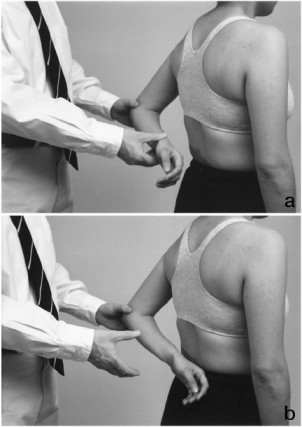
Bear Hug Test
The patient is instructed to perform the Bear Hug Test by placing the palm of their affected arm on the opposite shoulder and putting their elbow in the maximum anterior translation position. The patient is told to keep up with the beginning position, while the doctor applies an externally rotating power to the patient’s lower arm.
If the patient can maintain his arm position or if he or she exhibits weakness in internal rotation in comparison to the side on the opposite side, the test is positive, indicating a tear or dysfunction in the subscapularis muscle.
Belly Press Test
The affected arm is placed sideways with the shoulder flexed 90 degrees and the palm resting on the patient’s belly for the Belly Press Test. The patient is instructed to perform an internal rotation by pressing his palm against his belly.
If the patient shows weakness in internal rotation in comparison to the opposite side or is pressed on his belly with an elbow or shoulder extension rather than internal rotation, the test is positive.
Subscapularis muscle stretching
Towel Subscapularis Stretch
Stand erect. You can stretch with a towel.
Keep one end of a big towel in your left hand and arrive over your left shoulder.
Get the opposite finish of the towel despite your good faith, with your right hand.
Allow your right hand to slide up your back as you slowly lift your left hand overhead.
You ought to sense a stretch.
Hold it for 15-20 seconds and recount it multiple times.
Now move the hands in opposite directions.
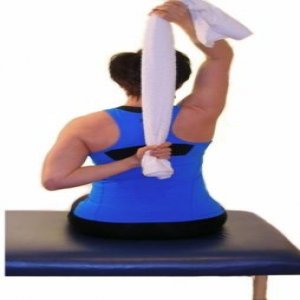
Subscapularis muscle strengthening exercise
Subscapularis active massage
A towel and a broomstick/dowel are used in this self-soft tissue mobilization method. A towel should be placed on one end of the broomstick and placed on an area of the subscapularis muscle that is tender. This muscle can be accessed through the armpit and is situated between the scapula and rib cage. Place medium strain onto the muscle gut and gradually inside and externally rotate the shoulder while it is raised close to you. You might do up to 3-5 counts on up to 2-3 spots, and maximally up to 2-3 times each week.
Internal rotation uppercuts
This rotator cuff strengthening exercise focuses on dynamic stabilization of the glenohumeral joint. Anchor the band down next to you by grabbing it with the arm closest to it. Keep your elbows aligned with your wrists while performing a shoulder flexion exercise. During this activity, keep the elbow twisted at 90 degrees. The forearm should be as close to vertical as possible during this movement.
90 degrees internal rotation
This shoulder-improving exercise targets the concentric constriction of the inward rotators. Behind you, place a band so that it is about head height. Keep the elbow abducted to bear level starting with your lower arm vertical with the floor. To increase tension, move forward while gripping the free end of the band. Pull the bar by rotating the shoulder inward until it is parallel to the floor. Return slowly to the starting position to complete a repetition.
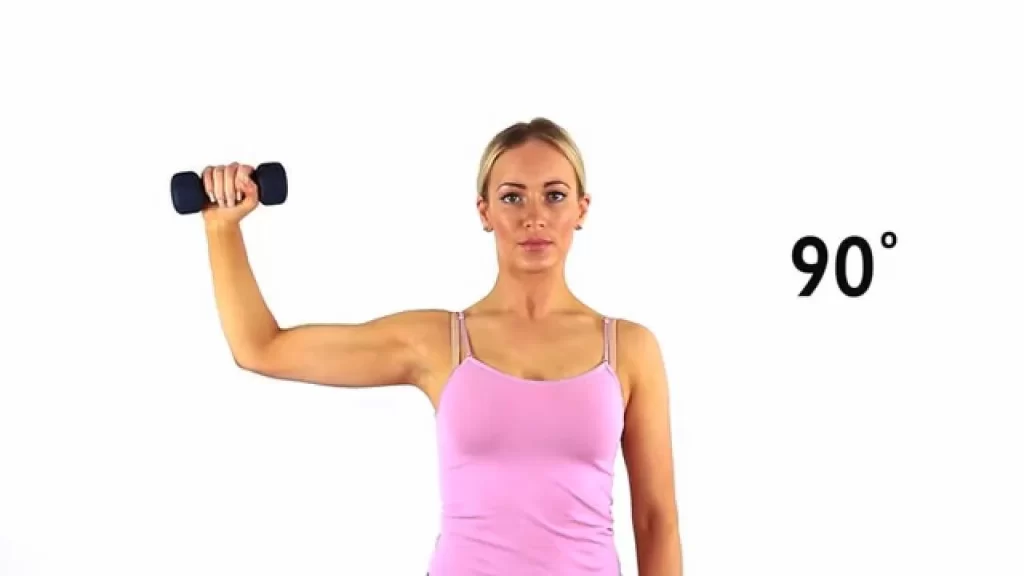
Internal rotation pull down
Using a strength band is a reinforcing exercise for the inward rotation of the shoulder. A steady pull-up bar above you should have a band on it. Line up your elbow with your fist and raise it to 90 degrees of abduction. Grab the band and pull it straight down without bringing down your elbows. Gradually turn it back up, and recount it as needs be.
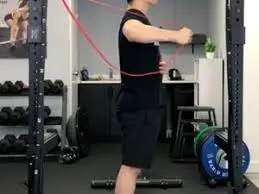
Shoulder isometric internal rotation
At 0 degrees of abduction, this is an isometric contraction of the shoulder internal rotators. Place your hand against the wall while standing in a doorway. Keep the hand parallel to the shoulder and elbow. Hold for 5-7 seconds by pressing inward with your hand with the most effort you can bear. Relax for 5-7 seconds after slowly letting go of the muscle contraction before doing it again.

Abducted shoulder internal rotation
This is an activity that improves shoulder internal rotation. A band should be anchored behind you at about ear level. Maintain a 90-degree elbow flexion while abducting to bear level. Hold the free finish of the bar with your clenched hand raised simply over your elbow. To increase the band’s tension, move forward. Move your forearm toward the floor until it is parallel to it. Recount as needs be.
Banded walkouts
An isometric constriction of the inward rotators is the goal of this shoulder stability exercise. A band should be anchored behind you at about ear level. Keep the elbow flexed to 90 degrees and took to bear level. Hold the free finish of the band with your clenched hand raised simply over your elbow. Step forward and hold the position for up to ten seconds without moving to increase the band’s tension. Return a stage to deliver strain in the band and rest for ten seconds prior to beginning once again.
Childs pose sliders
This is a shoulder stability exercise. To get started, place your hands on a towel or a slider disc. Incline down with your middle from a quadrupedal position and slide your hand to an above position on the ground simultaneously. Press the hand back down into the floor and lift the torso off the ground.

Prone press slider
The interior rotators of the shoulder are the essential focus of this unique shoulder strength workout. Begin by lying on your stomach and supporting your head with your forearm. Press the target arm into a sliding disc or hand towel to press it against the bottom. Maintaining downward pressure, slide your hand as high as you can above your head. The next step is to lower it once more until your hand is roughly parallel to your shoulder.
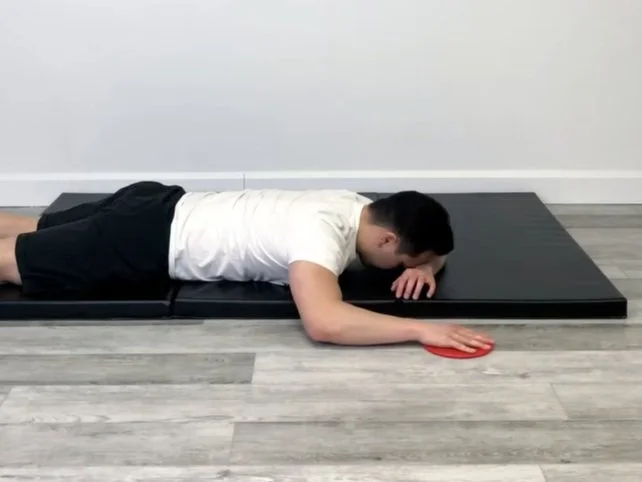
Internal rotation shoulder wall slide
This is a dynamic, in the sagittal plane, internal rotation exercise. To begin, stand in a doorway with a slider disc or hand towel between your hand and the wall. Make sure your hand and elbow are in line with your shoulder when you stand. To achieve 90 degrees of shoulder flexion, press inward with your hand within tolerable limits and slide it up the wall. While returning the hand to its starting position, maintain internal rotation.
Banded shoulder internal rotation
Shoulder flexion is an inner turn practice for the shoulder. To get started, hold the other end of a band close to the anchor point and anchor it beside you at eye level. As you bring the elbow into 90 degrees of flexion, pull the band into the internal rotation. Hold the end range for up to two seconds and then reverse the motion to complete a repetition.

Front band pull shoulder rotations
This is a shoulder mobility warm-up exercise. Connect one finish of a light-strength band to a steady item before you and circle it around the upper arm near the armpit. Pivot your arm all over to the extent that is agreeable while raising it to 90 degrees abduction.
Internal rotation front press
This rotator cuff strengthening exercise focuses on dynamic stabilization of the glenohumeral joint. Anchor the band down next to you by grabbing it with the arm closest to it. While keeping the wrist in accordance with the elbow, play out a front press. The forearm should be as close to vertical as possible during this movement.
Dowel shoulder pull
This is a shoulder internal rotation stretch done with a dowel. Hold a dowel despite your good faith with two hands while standing. Hold the dowel behind your neck with one hand and at the little of your low back with the other. With the healthy arm, move the target hand into a shoulder abduction that is manageable. After holding the end range for up to ten seconds, return to the starting position.
Internal rotation side step
An isometric constriction of the inward rotators is the goal of this shoulder security exercise. Place a band about the elbow level before the objective arm. Keep the elbow flexed to 90 degrees below the shoulder. Make sure the free end of the band is held in front of your elbow with your fist. Make a move to the side to fix the band, and stand firm on this foothold for as long as 10 seconds without moving. Step back inwards to diminish the band strain and rest for 10 seconds prior to describing.
FAQ
What kind of pain does subscapularis cause?
Shoulder pain, particularly in the front of the shoulder, is the most common symptom of a subscapularis tear. You could likewise hear or feel clicking in your shoulder when you turn your arm. A subscapularis tear exhibits many of the same symptoms as other rotator cuff tears.
How does pain in the subscapularis feel?
Common referral patterns of a tight and unhappy subscapularis muscle include pain in the neck, back, shoulder, arm, and wrist, and reduced strength in these areas.
How do you treat subscapularis pain?
Anti-inflammatory medication and hot or cold therapy can be used to treat a subscapular tendon that is mildly or moderately inflamed. During treatment, a patient will be advised to rest for at least one to two weeks to help prevent the condition from getting worse.
What amount of time does it require for a subscapularis to recover?
Following the subscapularis ligament medical procedure, the arm is kept in a unique sling to safeguard maintenance. After six to twelve weeks of healing, active shoulder motion exercises can be started.
How serious is a tear of the subscapularis?
It is the rotator cuff’s largest and most powerful muscle, and its tendon is the rotator cuff’s largest component. Injuries to the subscapularis tendon typically result in pain, a weaker shoulder, and issues with the biceps tendon, which is right next to it.

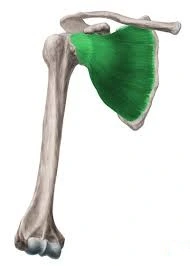

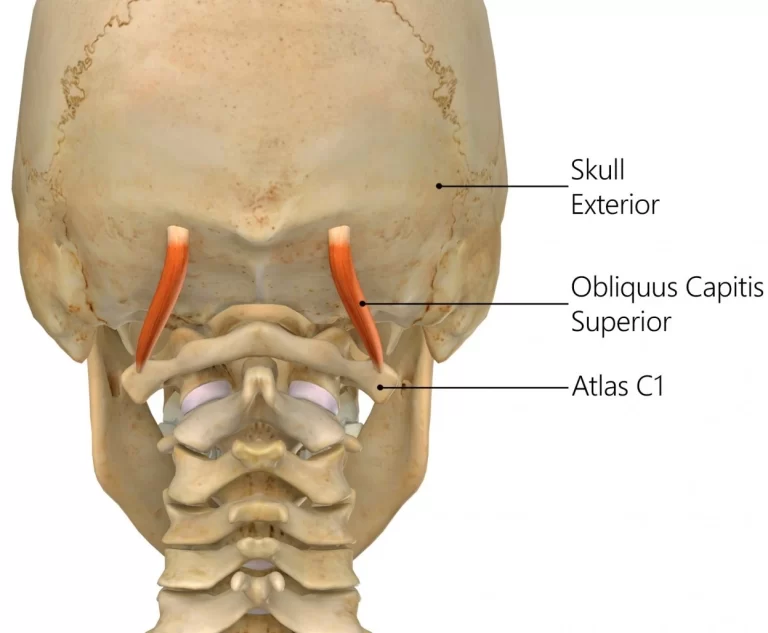
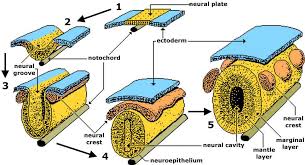
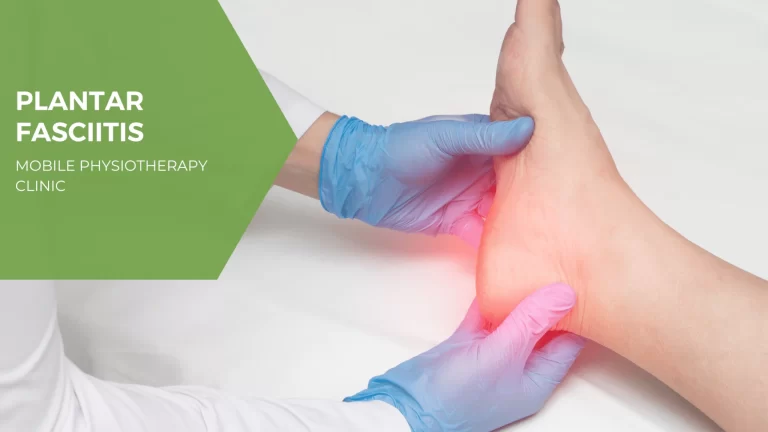
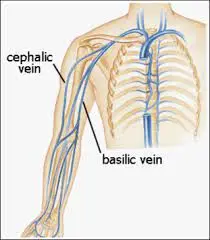

One Comment